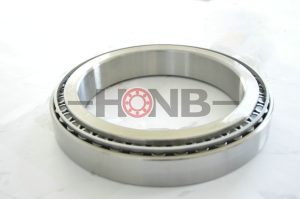Coefficient of Friction and Lubrication of Rolling Bearings
Author: hongyuanTime:
The sliding bearing shown in the reference value of the stable rotation friction coefficient under general conditions is generally 0.010.020.10.2 The friction coefficient of various bearings is the friction coefficient of the bearing type. In order to facilitate comparison with the sliding bearing, the friction moment of the rolling bearing can be calculated according to the inner diameter of the bearing by the following formula:
M=uPd/2 (M: friction torque, mN.m; u: friction coefficient, Table 1; P: bearing load, N; d: bearing nominal inner diameter, mm). The friction coefficient u is greatly affected by the bearing type, bearing load, rotational speed, lubrication method, etc. The reference value of the friction coefficient during stable rotation under general conditions is as follows.
For sliding bearings, generally u=0.01-0.02, sometimes up to 0.1-0.2. Composite bearing friction coefficient: 0.03~0.18
Bearing type Friction coefficient u
Deep groove ball bearing 0.0010-0.0015
Angular contact ball bearing 0.0012-0.0020
Self-aligning ball bearing 0.0008-0.0012
Cylindrical roller bearing 0.0008-0.0012
Full complement needle roller bearings 0.0025-0.0035
Needle roller bearing with cage 0.0020-0.0030
Tapered roller bearing 0.0017-0.0025
Spherical roller bearing 0.0020-0.0025
Thrust ball bearing 0.0010-0.0015
Thrust spherical roller bearing 0.0020-0.0025
4. Selection of rolling bearing lubrication method
Rolling bearing is an important mechanical component. Whether the performance of a mechanical equipment can be fully exerted depends on whether the bearing is properly lubricated. It can be said that lubrication is a necessary condition to ensure the normal operation of the bearing. It is important for improving the bearing capacity and Lifespan plays an important role. No matter what kind of lubrication form is used, lubrication can play the following roles in rolling bearings:
(1) Reduce the friction between metals and slow down their wear.
(2) The formation of oil film increases the contact area and reduces the contact stress.
(3) Ensure that the rolling bearing can operate normally for a long time under high-frequency contact stress, prolong the fatigue life,
(4) Eliminate frictional heat, reduce the temperature of the working surface of the bearing, and prevent burns.
(5) Play the role of dustproof, rustproof and anticorrosion.
Therefore, proper lubrication is very important for the normal operation of rolling bearings. The content of the lubrication design of rolling bearings mainly includes: the determination of reasonable lubrication methods, the correct selection of lubricants, the quantitative calculation of lubricant dosage and the determination of oil change intervals. Rolling bearing lubrication can generally be divided into three categories according to the type of lubricant used: oil lubrication, grease lubrication and solid lubrication. Among them, oil lubrication has a wider temperature range than other lubrication methods, and is more suitable for bearings working under high-speed and high-load conditions; at the same time, due to oil lubrication, it is also convenient for equipment maintenance and lubricant replacement, and the friction pairs in the system such as gears, etc. The advantage of being able to lubricate at the same time, so far, the use of oil lubrication for bearings is the most common. Grease lubrication has the advantages of simple sealing device, low maintenance cost and low grease cost, etc. It is widely used in bearings operating at low speed, medium speed and medium temperature. Especially in recent years, the advent of anti-wear additives has improved the lubricating performance of grease, making grease lubrication more widely used. If oil lubrication and grease lubrication cannot meet the lubrication conditions required by the bearing, or cannot meet the specific working conditions, solid lubricants can be used, or try to improve the lubrication performance of the bearing itself.
The speed of the bearing is mainly limited by the temperature rise caused by the frictional heat inside the bearing. When the speed exceeds a certain limit, the bearing will not continue to rotate due to burns, etc.
The limit speed of the bearing refers to the limit value that does not generate frictional heat that causes burns and can rotate continuously.
Therefore, the limit speed of the bearing depends on various factors such as the type, size and precision of the bearing, the lubrication method, the quality and quantity of the lubricant, the material and type of the cage, and the load conditions.
The limiting speeds of various types of bearings when using grease lubrication and oil lubrication (oil bath lubrication) are listed in the bearing size tables respectively, and the values indicate that the standard design bearings are under normal load conditions (C/P>=13, Fa/Fr<= 0.25 or so) the limit value of the rotational speed when rotating.
In addition, depending on the type and brand of the lubricant, although it may be better than other properties, it is not suitable for high-speed rotation.
________________________________________
Correction of limit speed
Load condition C/P<13 (that is, the equivalent dynamic load P exceeds about 8% of the basic rated dynamic load C), or when the axial load in the combined load exceeds 25% of the radial load, use the following formula to determine the limit The speed is corrected.
*****************
Na=f1*f2*n
*****************
here,
na: revised limit speed, rpm
f1: Correction factor related to load conditions (Figure 8.1)
f2: Correction factor related to synthetic load (Figure 8.2)
n: limit speed under normal load conditions, rpm (refer to the bearing size table)
C: Basic rated dynamic load, N{kgf}
P : Equivalent dynamic load, N{kgf}
Fr: radial load, N{kgf}
Fa: Axial load, N{kgf}
________________________________________
Limiting speeds of sealed ball bearings
The limit speed of the ball bearing with contact sealing ring (RS type) is limited by the linear velocity of the contact surface of the sealing ring, and the allowable linear speed depends on the rubber material of the sealing ring.
______________________________________
Precautions for high-speed rotation
When the bearing rotates at high speed, especially when the speed is close to or exceeds the limit speed recorded in the dimension table, the following items should be paid attention to:
(1) Use precision bearings
(2) Analyze the internal clearance of the bearing (considering the reduction in the internal clearance of the bearing due to temperature rise)
(3) Analyze the type of cage material (for high-speed rotation, it is suitable to use copper alloy or phenolic resin cutting cage. In addition, there are synthetic resin molded cages suitable for high-speed rotation)
(4) Analyzing the lubrication method (using circulation lubrication, spray lubrication, oil mist lubrication and oil-air lubrication suitable for high-speed rotation)
________________________________________
Coefficient of friction of bearings (reference)
In order to facilitate comparison with sliding bearings, the frictional moment of rolling bearings can be calculated according to the inner diameter of the bearings by the following formula:
*****************
M=uPd/2
*****************
here,
M: Friction torque, mN.m{kgf.mm}
u: coefficient of friction, Table 1
P: Bearing load, N{kgf}
d: bearing nominal inner diameter, mm
The friction coefficient u is greatly affected by the bearing type, bearing load, rotational speed, lubrication method, etc. The reference value of the friction coefficient during stable rotation under general conditions is shown in Table 1.
For sliding bearings, generally u=0.01-0.02, sometimes up to 0.1-0.2.


We have rich experience on precision bearing manufacturing and are ranked NO.1 in China and NO.3 all over the world.
We can tailor the overall solution for the use of precision bearings.
HONB– Accountability & Innovation
Products
- YRT rotary table bearing
- YRTS rotary table bearing (high speed series)
- YRTM with integral angular measuring system series
- ZKLDF axial angular contact ball bearing series
- RA series crossed roller bearing
- SX series crossed roller bearing
- CRBH series crossed roller bearing
- RE series crossed roller bearing
- RU series crossed roller bearing
- RB series crossed roller bearing
- XR/JXR series crossed taper roller bearing
- Crossed roller bearing
Contact Us

✉️ bearing20@hyzcgroup.com
📞 +86 15236685001





